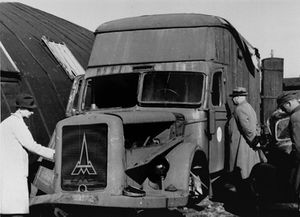Szymon Srebrnik (M / Poland, 1930-2006), Holocaust survivor
Szymon Srebrnik (M / Poland, 1930-2006), Holocaust survivor.
- KEYWORDS : <Poland> <Lodz Ghetto> <Chelmno> <mascots> <errand boys> <witnesses>
Biography
Born in Lodz in 1930, Szymon lived the hardships of the Lodz Ghetto. His father was killed before his eyes at Lodz. In 1944 Szymon (age 13) and his mother were deported to Chelmno. The mother died in the gas vans (there were no gas chambers in Chelmno). The carbon dioxide emissions from the engine were pumped into the back of the van, and by the time the driver had reached the burial site in a nearby forest, all of the Jews would be dead. If any of them happened to still be alive, they were shot. The bodies were disposed of by either burial or burning.
A small number of strong, healthy men were kept alive for awhile in order to help dispose of the bodies and sort through all the belongings of the dead Jews. They were kept in iron shackles 24 hours a day to prevent escape. They slept in the granary. These people were usually killed within days or weeks and replaced by others from new transports. Our Szymon, however, lasted for about ten months, as he became a sort of mascot of the camp. Although chained as all the other prisoners he was very agile and funny and entertained the German soldiers with his singing. This did not prevent the SS to shoot him in the head at the liquidation of the camp.
On the night of January 17-18, 1945, two days before the Russian troops arrived, the German camp Kulmhof (Chełmno nad Nerem) was evacuated and the SS men, under the command of Hans Bothmann, began the liquidation of the last surviving prisoners. The last 47 prisoners were held in a granary in Chełmno. Among them were craftsmen and people responsible for covering up the traces of the crime. It was on that very night that a group of SS men surrounded the granary where the prisoners were staying. The prisoners were led out in groups of five and then shot. Aware of their fate, the prisoners took advantage of the moment of inattention of the German torturers, instigating a revolt. Two guards who entered to shoot the next group were attacked by desperate prisoners, and died as a result. Seeing the whole situation, the camp commandant, Bothmann, ordered the doors to be closed and the granary, which still held alive prisoners, set on fire. SS men also started firing at the granary. Two people miraculously survived the liquidation. One of them was Szymon Srebrnik, who was among the prisoners led out by the SS and shot. He was shot in the neck. The bullet passed through his mouth and nose and then he passed out. The second person who managed to survive was Mieczysław Żurawski. He took advantage of the commotion in the granary and made an attempt to escape. Despite an organized pursuit, he managed to hide and survived the massacre and the death camp at Kulmhof.
The following excerpts from the statement of Szymon Srebrnik describe the events of the night of January 17-18, 1945:
- “When the Soviet troops were approaching […], all the workers were called in and ordered to leave in fives - the area was illuminated by car refractors. I came out in the first group of five: Lenz (Wilhelm Lenz - a member of the SS crew - author's note) ordered to lie down on the ground. He fired his revolver in the back of each person’s head, one by one. I passed out. I regained consciousness when there was no one around me. All SS men fired inside the granary. I crawled over to the car which illuminated the area and broke both refractors. Taking advantage of the darkness, I escaped. The wound was not fatal. The bullet passed through the neck, passed through the mouth and, piercing the nose, came out."
Szymon Srebrnik - survivor of Kulmhof extermination camp
Szymon miraculously survived lying in a pile of dead bodies. The bullet had missed his vital brain centers. When he regained consciousness, he managed to escape. A Polish farmer found him, freed him from his chains, and sheltered him until the arrival of the Russian doctors.
After liberation Szymon became one of the main witnesses against Nazi atrocities in Poland (only three people are known to have survived at Chelmno). This is the text of the testimony he gave on June 29, 1945:
In September 1945 Szymon emigrated to Israel. He went on to testify at Adolf Eichmann‘s trial in 1961, and in 1978, he went back to visit Chelmno for Claude Lanzmann’s film documentary Shoah.
- Shoah (3m-9m)

